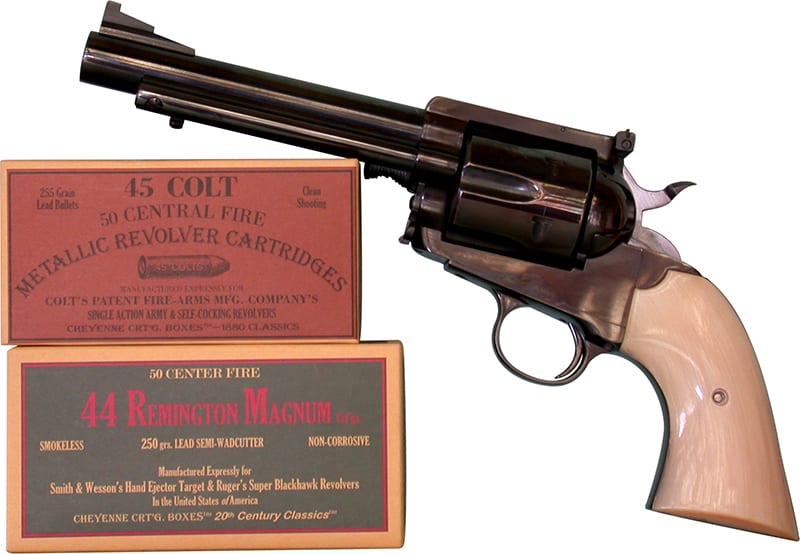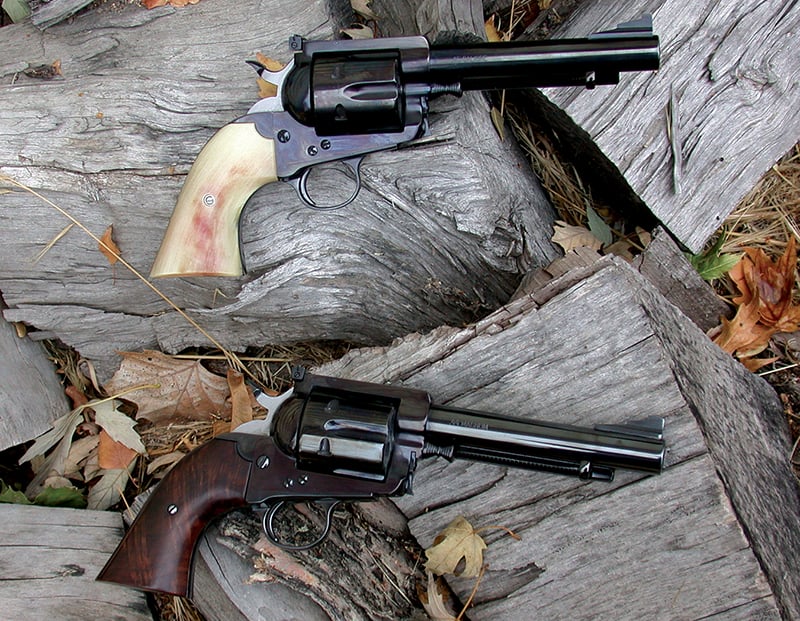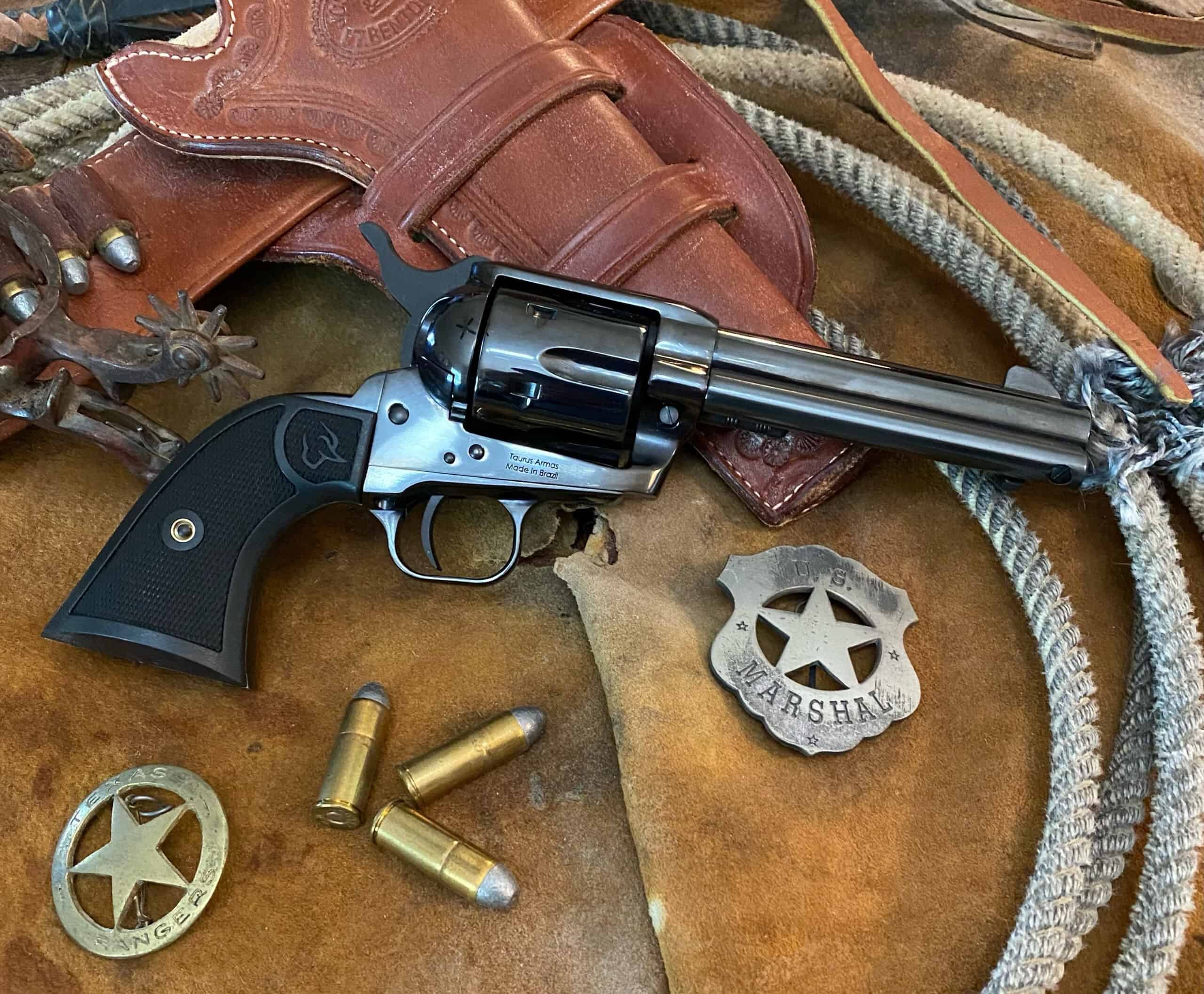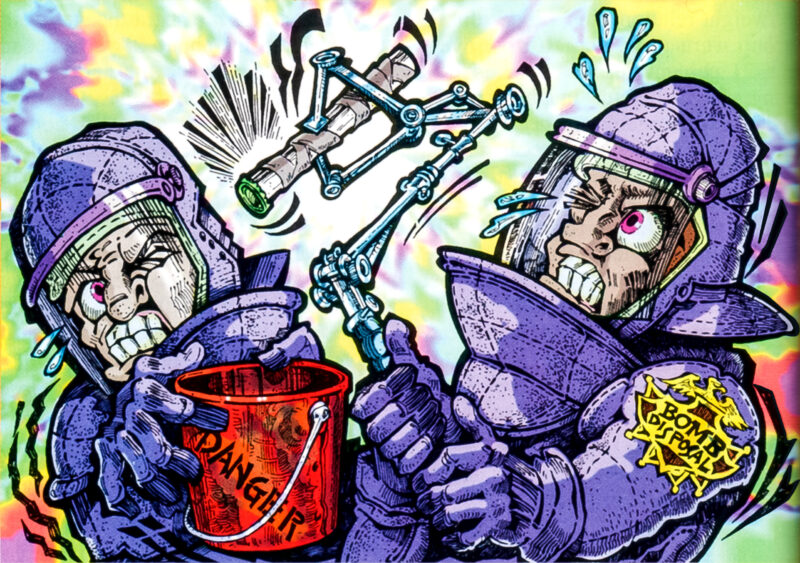The No. 5 Single Action
Saluting A Fine Sixgun Made By A Master
Call it nostalgia, traditionalism or even sentimentalism, maybe throw in some hero worship. Whatever you choose to call it, I have a special feeling handling the special sixguns once belonging to special people. It is one thing to go to a museum and see so many firearms belonging to so many famous people as one finds at the Buffalo Bill Historical Center and Winchester Museum in Cody, Wyoming, however a much different feeling occurs when actually handling well known firearms.
Probably the most soul-stirring experience when it comes to special sixguns was to not only handle all of Elmer Keith’s sixguns, but to actually unload his old .45 Colt after he went Home, and there is no way to describe the feeling experienced when actually being privileged to handle his No. 5 referred to in his many articles. There’s a specific reason for this custom Colt Single Action being called the No. 5. In his monumental book, Sixguns, he relates a visit to his ranch in the 1920s by one Harold Croft of Philadelphia and how he brought a “whole suitcase full of sixguns” when he came to visit. Four of those sixguns were custom Croft Featherweight .45s written up in the September 1928 issue of The American Rifleman. Those four sixguns, all lightweights as Crofts specialized in lightened versions of Colt Single Actions, were numbered One through Four.
Croft was not a gunsmith but rather used top gunsmiths of the time to carry out his ideas. Those gunsmiths were R.F. Sedgley and Neal Houchins. All four models featured lightened frames and loading gates, cut out recoil shields, and no ejector rod housings. All, of course, were chambered in .45 Colt and all featured adjustable sights. No. 1 was a Single Action with a flattop frame and a special cylinder release catch. The other three all started as Bisley Models with altered grip frames. No. 4 had been an original Flattop Target Bisley and, being such a special sixgun, was fully engraved.
Keith was highly interested in Croft’s sixguns except his desire was for a greatly improved full-sized revolver that would eventually become his favorite single action and one he carried daily for 30 years. Keith says of his revolver, which became No. 5, “My friend O’Meara is now working over a Bisley, and fitting a S.A.A. guard and frontstrap. He is also bending the Bisley backstrap to the S.A. Army angle. His grip will extend about one-eighth inch higher at base of hammer, due to the difference in the frames of the Bisley and S.A. Army, but it should be very similar to the grip of this No. 3 Featherweight. No. 3 has a hammer with something similar to that of No. 1 and I believe made from a regular S.A. hammer, with a piece attached to conform with the Bisley in shape and to fill the large cut in the Bisley backstrap. The mainspring is like that of the regular S.A. Army, and does not engage a stirrup as in the case of the Bisley. For the ideal heavy belt 6-gun I believe that a 5 1⁄2″ Bisley or S.A. Army, fitted with flat-top frame and sights like those of No. 1 or No. 4, with Bisley backstrap and S.A. Army frontstrap and guard, Bisley hammer and trigger, ejector left on, and with Croft’s base-pin catch and a tool-steel pin with a large head similar to, though shorter than, the one on No. 4, and with the frame left full weight, would be the ideal gun for this country and for the hills in general.” (Sept 1928.)
The No. 5 Is Born
Six months later in the April 1929 issue of The American Rifleman Keith unveiled “The Last Word.” As the title indicates he felt the No. 5 was the finest single action sixgun it was possible to build. All three gunsmiths, Sedgley, Houchins, and O’Meara contributed to his new 5 1⁄2″ No. 5 .44 Special. This highly customized Colt featured adjustable sights with interchangeable front blades, special base pin and basepin catch, flattopped frame, fully engraved and fitted with ivory stocks, and the No. 5 grip frame. Croft’s ideas had a great influence on Elmer Keith, however it also worked the other way as the aforementioned No. 2 was converted from .45 Colt to .44 Special right after Croft visited Keith. There are two 1920s dates inscribed on this special sixgun; fellow gun writer Brian Pearce and I both surmised the first date indicates its original completion, while the second date signifies its upgrading to .44 Special.
The No. 5 sixgun began Keith’s three-decade promotion of heavy loads in the .44 Special that would eventually result in the advent of the .44 Magnum. This was also the sixgun for which Keith designed the no. 429421 bullet, which was unveiled in this same article. At the same time his call for an improvement in sixgun powders would soon be followed with the introduction of Hercules No. 2400. That bullet and that powder would be associated with Keith from 1929 on with the .44 Special and then the .44 Magnum. Keith died in 1984, however it is a rare sixgunner who cannot identify the Keith Load when it comes to both the .44 Special and the .44 Magnum.
Remaking a Classic
We now fast forward from the 1920s to the 1980s. On the 60th anniversary of the building of the original No. 5 by Keith, Croft, Sedgley, Houchins, and O’Meara, custom gun maker Bill Grover of Texas Longhorn Arms decided to build a gun as a memorial and remembrance to Elmer Keith. Grover had been carrying a long fascination with the original No. 5 ever since he had purchased an autographed copy of Keith’s book Sixguns in 1964. In between, Grover had started Texas Longhorn Arms in 1981 building a single action sixgun different than anything that had ever been previously offered.
Grover was also a fan of Sam Colt and the Colt Single Action. It was his belief Sam Colt was left-handed and his designs show this. Now Sam had died 10 years before the advent of the Colt Single Action Army, however the legendary SAA works exactly as did the cap and ball revolvers before it. If you are righthanded, as I am, you probably cap percussion revolvers with your right hand while holding the sixgun in your left hand. It just seems natural. For both loading and unloading a Single Action Army, I also switch the sixgun to my left hand working the ejector rod with my right hand and also using my right hand to reload and then switch the sixgun back to my right hand for either holstering or shooting. Grover’s idea was to reverse everything.
That is both the ejector rod housing and the loading gate are on the left side of the sixgun and the cylinder rotates counterclockwise. This allows the right-handed shooter to hold the gun in his right hand while both loading and unloading operations are performed with the left hand. The sixgun never leaves the shooting hand. It makes sense, however it does take some getting used to for one who has spent many decades doing it the other way with Colt, Ruger, and Great Western single actions.
Grover’s first “righthanded” single actions were the West Texas Flattop Target and the South Texas Army. The Target Model had a 7 1⁄2″ barrel and was offered mainly in .44 Magnum and .45 Colt. The South Texas Army with fixed sights normally had a barrel length of 4 3⁄4″ and was also offered as a .44 and .45. Both of these guns may be rarely found in other chamberings. Years ago, Grover sent me his personal 7 1⁄2″ Target Model chambered in .44 Magnum. I immediately called him and began negotiating purchasing this beautiful, and beautifully shooting, revolver. When the deal was finally struck, it was returned to Texas Longhorn Arms to have two more cylinders fitted, one in .44 Special and the other in .44-40.
I have very pleasant memories of this three cylindered sixgun due to a Texas hunt with Grover on the ranch of my dear friend Frank Pulkrabek who was later killed by a drunken driver. The plan on this particular hunt was to take three animals, one with each of the three .44s, in one day. The two extra cylinders were loaded, placed in a sock and tied to my belt. During the course of the afternoon I walked the hills and canyons of Frank’s ranch taking a Catalina goat, an Angora goat, and a Marino ram using the three different cylinders in three different calibers. Since that time, the .44 Target Model has been fitted with a fourth cylinder chambered in .44 Russian. The next step in the plan was to fit one more cylinder in .44 Colt, however it was not to be.
My South Texas Army has only one cylinder, that being in .44 Special. Both of these sixguns have grip frames much closer to the 1860 Army than the 1873 Army. The former grip has a slightly different angle, being a little straighter than that found on the Colt Single Action Army and it is also longer allowing room for the little finger, which no longer has to either dangle in space or be wrapped under the butt. Texas Longhorn Arms grip frames are exceptionally comfortable when shooting heavy loads.
A third sixgun offered by Texas Longhorn Arms was the Border Special. Long before any other companies were offering round-butted grip frames whether on Colts, Rugers, or replicas, TLA’s Border Special featured a short barrel with an ejector rod housing and a round grip frame. It was especially comfortable when shooting .44 Magnum loads.
That brings us up to the mid-1980s. At the SHOT Show in 1986, Grover met with Dan Love who had plans and patterns of the No. 5 he had received from Elmer Keith in 1971. Love was also able to obtain pictures of the original gun from Elmer’s son Ted. At the next SHOT Show, Grover met with several interested and talented individuals discussing what would become the Improved Number Five. Several of these men went back to the Texas Longhorn Arms factory and spent the next two weeks building the Improved Number Five by starting with a block of steel, machining parts, making workable patterns, springs, sights, and screws.
Grover relates the following: “We had Bill Oakes from Lancaster, Kentucky, Dan Love from Arthur, Iowa, Bill Konig, a renowned grip maker from Centerville, Tennessee and Robert Luna from Pleak, Texas, a very fine hand polisher. I sat down in the shop and drew out the plans as to what each one would be doing. All work and design was done in the Texas Longhorn Arms factory. To do a pilot model from scratch in two weeks is quite an accomplishment.
“Gripmaker Bill Konig was working with Dan Love and myself on the newest one-piece type grip that would fit on the Bisley type model with no screw holes going through either side as all other Bisley type grips have. The one-piece look is a much better appearance. Ours have no side screws. As this was going on, I turned to Master Machinist Keith DeHart of Houston, Texas for assistance with the base pin and lever latch. I showed DeHart what I wanted, pointing out that we had to make it in reverse as my right-handed single actions were the opposite of the Colts and the original No. 5 was a Colt.”
The Improved No. 5
Grover sent me the original Improved No. 5 serial number 1 for testing in 1988. Not only was I able to test this Number Five, I also compared it to the original. Keith died in 1984 however, I was able to meet with Elmer’s son Ted and photograph the two sixguns side-by-side and also hold one in each hand. As expected the grips felt the same. There’s no doubt the grip frame of the No. 5 inspired Bill Ruger to build the Bisley Model Ruger. However, the Ruger Bisley grip frame is much larger than the Keith design as Elmer had smaller than normal hands. Because of the size of the No. 5 grip frame, I found your grip must remain very consistent to acquire the best results,
accuracy wise.
The Improved No. 5 from Texas Longhorn Arms managed to maintain the flavor of the original while being stronger and replacing Keith’s favorite cartridge of the 1920s-1950s with his choice from 1955 on, the .44 Magnum. Even with its larger frame and cylinder, the TLA No. 5 still maintains Colt-style balance rather than seeming overly large.
I have already mentioned the fact all TLA sixguns had the ejector rod housing and loading gate on the left side for natural use by right-handed shooters. Other features of the Improved No. 5 include a rounded triggerguard with a shotgun style trigger that sits as far back in the triggerguard as possible and also moves very little as the hammer is cocked. The hammer spur rides low and is wide for easy cocking, the top strap is of the flattop style fitted with a Micro-style adjustable rear sight matched up with a Patridge front sight. Improved No. 5s were originally machined from a block of 4140 aircraft steel. Grover later switched to frame castings from Pine Tree Castings which also makes Ruger sixgun frames.
In comparing the Keith No. 5 with the Grover Improved No. 5 we find both identical features and improved features. The former includes the grip frame, the cylinder base pin latch release, and a 5 1⁄2″ barrel. Differences are the right hand/left hand features already described, the onepiece style grip, a larger frame with a double-heat-treated cylinder chambered in .44 Magnum, crafted of 4140 aircraft steel, coil springs, rounded triggerguard, frame-mounted firing pin, improved adjustable sights, a larger ejector rod head, and the fact no frame screws protruded to the left side of the sixgun.
Grover’s original plans were to build 1,200 Improved No. 5s in .44 Magnum with 5 1⁄2″ barrels. After testing the original I ordered serial number K44, which I now have, and also purchased an identical Improved No. 5 chambered in .45 Colt. The plan of 1,200 .44 Magnums never materialized, nor did the 1,000 each of the West Texas Flat Top Target and South Texas Army. In addition to the standard guns there were a few fully factory engraved models and at least one stainless steel No. 5 built by Grover. On several hunting trips together he also showed me special guns with folding leaf express style sights.
In addition to his Texas Longhorn Arms models, Grover also built a few other custom guns. Two of these for me were both .44 Specials using Ruger Old Model frames.
One of these is a 7 1⁄2″ with custom fancy walnut grips by Charles Able and the other a 4 3⁄4″ Packin’ Pistol with a Colt Single Action grip frame fitted with onepiece ivory grips by BluMagnum. The long-barreled sixgun is serial number JT1. The Packin’ Pistol .44 Special is one of seven. The first for Skeeter Skelton was SS1, mine is SS4. SS2 belongs to Bart Skelton, Bob Baer has SS3, Jim Wilson SS5, Terry Murbach, SS6, and Grover has SS7. There will be no more. Both of these sixguns fit in my Very Special Sixguns category.
Texas Longhorn Arms offered a unique product in an uphill battle. They were never ever able to keep up with orders nor have enough working capital and finally closed their doors in 1998. Today all TLA sixguns can be viewed as collectors items, however mine remain working collectibles. I never like trying to identify “my favorite sixgun,” however several years ago I referred to my favorite type of sixgun, that being a 7 1⁄2″ adjustable sighted big bore single action. The TLA West Texas Flattop Target and custom .44 Special on an Old Model Ruger frame are very special sixguns in my favorite category.
While they can still be found occasionally at gun shops, shows, and auction sites, we will probably never see the production of Texas Longhorn Arms sixguns again. It would be wonderful if someone with plenty of financial resources would underwrite the return of the Improved Number Five, the South Texas Army, the West Texas Flattop Target, and the Border Special. I can at least hope.
A Tribute to the Old Master
Al DiPrima of Impact Custom Arms wanted to do something to pay back the firearms industry for all the pleasure he has derived in his shooting life. It would take eight years of work and planning on the part of several individuals, however the results were well worth the time and effort involved. Bill Grover of Texas Longhorn Arms donated a .44 Magnum Improved No. 5 to start the project. This sixgun was then sent to Ken Kelly at Mag-Na-Port for porting and a custom inverted muzzle crown. DiPrima then contacted Terry Wallace of Vallejo, California, who is well known for engraving work on high-grade rifles and shotguns, to do the engraving.Working in between the projects that paid his bills, it took five years to complete the engraving.
The engraved Improved No. 5 was then sent to The Gold Line Co. in Wolcott, Connecticut, for a finish of nickel with gold accents. Master Gripmaker Roy Fishpaw of Lynchburg, Virginia, supplied the ivory stocks and Don Brown of Ted Blocker Holsters supplied a beautifully carved Texas Hi Ride holster. For anyone looking for the best in sixgun stocks or quality leather, both of these men are highly recommended. A high-quality classic sixgun deserves a special resting place and Gordon Marts of Santa Fe, New Mexico, crafted a 19th century style fitted case of Madagascar Mahogany. In addition to providing security for the Improved No. 5, this locking case also holds the custom holster and 24 rounds of .44 Magnum ammunition.
Elmer Keith’s original No. 5 SAA was fully engraved and fitted with the ivory stocks. This current one of a kind No. 5 is a fitting tribute to the Old Master. The original purpose was not only to build a superb sixgun but also to raise money for a worthy project. It was sold for $9,000 and the money placed in The Shootists Building Fund for a future building at the Whittington Center in Raton, New Mexico.

Get More Revolver Content Every Week!
Sign up for the Wheelgun Wednesday newsletter here:













